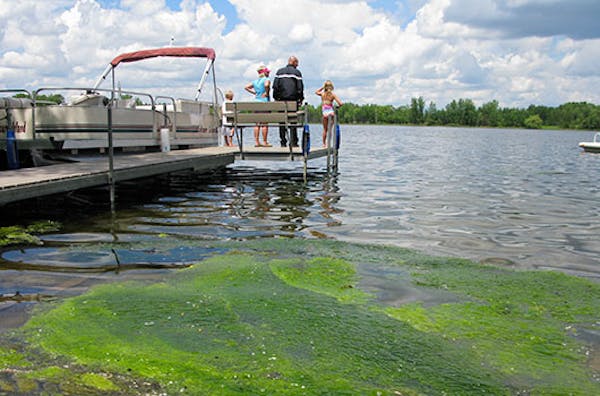A Minnesota child has become critically ill with a rare brain infection caused by a freshwater amoeba after swimming in Pope County's Lake Minnewaska, the Minnesota Department of Health announced Tuesday evening.
Health officials believe the child developed a rare form of meningitis known as primary amebic meningoencephalitis (PAM), which is caused by an amoeba known as Naegleria fowleri that is associated with warm, freshwater areas. The amoeba causes a severe brain infection that is almost always fatal. It infects humans by entering the body through the nose — typically while swimming — and cannot be contracted through drinking contaminated water.
State officials did not identify the child, but a family-created CaringBridge site identified him late Tuesday as Hunter Boutain of Alexandria, Minn., and said he is being treated for the infection at University of Minnesota Medical Center in Minneapolis.
Information posted by Hunter's uncle, Bryan Boutain, Tuesday evening indicated that the 14 year old was largely unresponsive and breathing with the help of a respirator.
"We are praying for a miracle for this rascal," the uncle wrote.
The site indicated that Hunter had come in contact with the parasite while lake swimming and said it was a "perfect storm of situations and circumstances."
Symptoms, including headaches, vomiting and nausea typically occur about five days after exposure. Although risk of infection from Naegleria is low, MDH Waterborne Diseases Unit Supervisor Trisha Robinson said there are a few tips for limiting your chances.
"While the only sure way to prevent PAM is to avoid participation in freshwater-related activities, you can reduce your risk by keeping your head out of the water, using nose clips or holding the nose shut, and avoiding stirring up sediment at the bottom of shallow freshwater areas," she said.
This case is the first reported in the state since a 9-year-old boy died from the disease after swimming in Stillwater's Lily Lake in 2012. A 7-year-old girl, who had also taken a dip in the shallow lake, succumbed to the illness in 2010.
Naegleria is commonly found all over the world. However, infections are very rare. Forty cases were reported in the United States from 2001 to 2011, nearly all in the South.
Prior to the 2010 Minnesota case, the infection had not been detected north of Missouri. That report broke the record by around 550 miles, Robinson said, and this infection is now the northernmost case on record in the country.
All Naegleria cases are confirmed by the Centers for Disease Control and Prevention, which has no reliable test for the organism. Cases are more commonly diagnosed in children, Robinson said, because they are more likely to take part in outdoor activities that make them susceptible.
Notification is not routinely posted at lakes after single cases and will not be at Lake Minnewaska, about 50 miles west of St. Cloud, because officials say it is not an effective way to prevent illness.
"Water users in general should assume that Naegleria fowleri is present, or can be present, in any freshwater — particularly warm fresh water," Robinson said. "Posting a sign at one body of water may give a misconception that bodies of water without a sign are Naegleria free, which is not true."
Lily Lake cases
In Minnesota, the rare brain infection was largely unknown until 2010 when 7-year-old Annie Elizabeth Bahneman of Stillwater died after swimming at Lily Lake. Two years later, 9-year-old Jack Ariola Erenberg, also of Stillwater, died after swimming in the same lake, which had a public beach.
Annie's death was the first in Minnesota from the illness — a form of meningitis — and probably the first in a Northern state, the Minnesota Department of Health said at the time. She died at Children's Hospital in St. Paul four days after she fell sick with vomiting and a headache.
Jack had fallen ill and became dizzy while camping with his mother and other family members in the Grand Marais area, on the North Shore of Lake Superior. At first, doctors thought it was flu, and Jack returned to camp. After he became sicker, with a bad headache, a medical helicopter flew him from Grand Marais to Duluth, where he died.
Jack's father, Jim Ariola, has sued the city of Stillwater, alleging that city officials altered the bottom of Lily Lake to create a shallow area, resulting in especially warm water uniquely favorable to the Naegleria fowleri amoeba.
The city has argued that it couldn't prevent an amoeba that's naturally occurring in the environment.
One of the unconfirmed cases in Minnesota involved the death of 12-year-old Hailee Marie LaMeyer of Stacy, Minn., who died in 2008 after swimming in Fawn Lake near her home. Her family has said that circumstances of her death mirrored those involving Annie and Jack, but testing of cerebral spinal fluid came too late to offer conclusive proof.
The microscopic flesh-eating amoeba, invisible to the human eye, becomes dangerous to humans when it enters the nose and travels to the brain, where it kills tissue and causes inflammation and death.
Staff Writer Kevin Giles contributed to this report.
jeremy.olson@startribune.com • 612-673-7744
liz.sawyer@startribune.com • 612-673-4648

Fall or spring, it's Rochester Mayo's year in prep tennis

Minneapolis reaches $150k settlement with eyewitness of George Floyd's murder

Israel-Hamas war creates 'really fraught times' at Minn. colleges

Rare and fatal brain disease in two deer hunters heightens concerns about CWD

